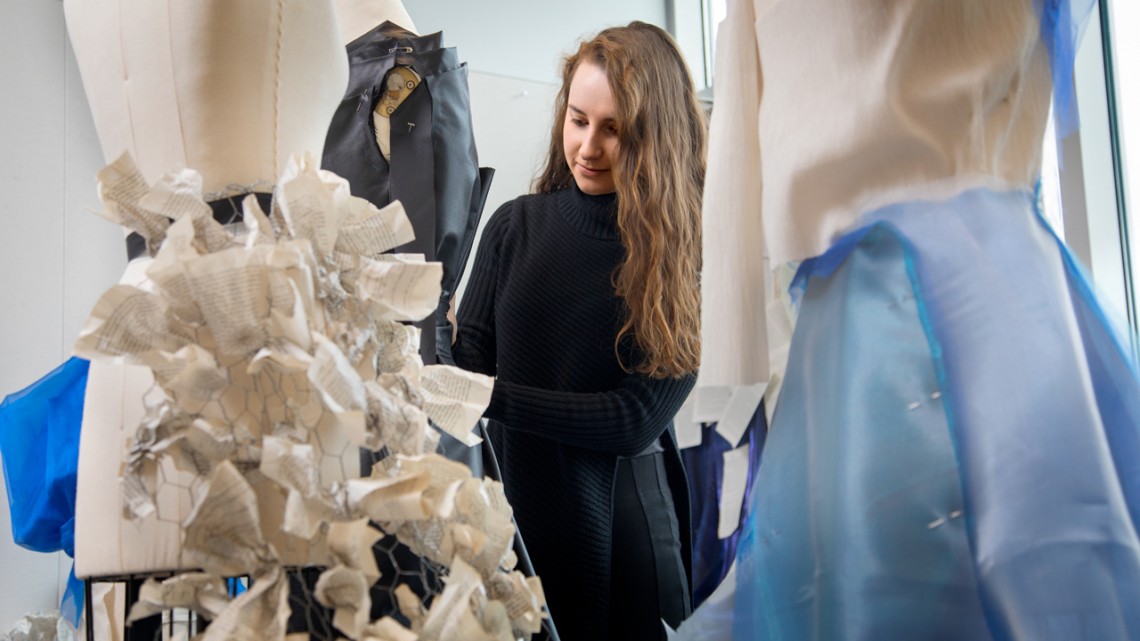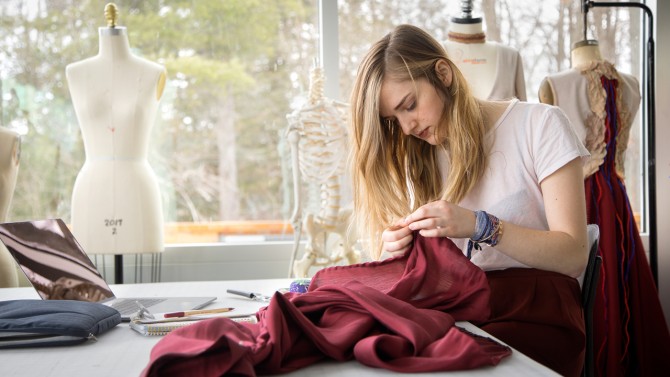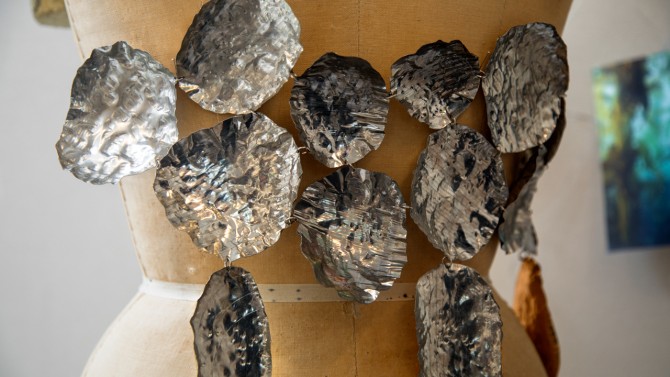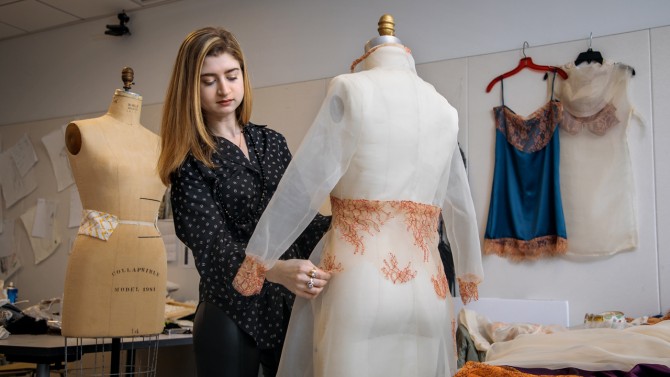
Taking pages from Sir Arthur Conan Doyle for her “Spectrum of Paradox” collection, Jacqueline Fogarty ’18 was inspired by Doyle’s transition from skeptic to spiritualist. The collection juxtaposes logic and belief, from a closed-umbrella shape to an ethereal flowing presence.
Designers prep for 34th annual Runway Show
By Daniel Aloi
With materials ranging from locally sourced fibers to reclaimed scraps from clothing manufacturers, and designs from transparently human (and feminine) to one-size-fits-all, the 2018 Cornell Fashion Collective (CFC) Runway Show, March 10 in Barton Hall, has it all.
The innovative thinking of 29 student designers will be on display in a variety of fashions, from a line inspired by the human body’s inner workings to conceptual representations of feminine power, skepticism and spirituality, consumption and indulgence, and social connectedness.
“It’s a very unique thing for Cornell students; it really lets us have an inside look at the industry,” Tuyen Nguyen ’20, CFC’s vice president of public relations, said of the annual production.
The student-run organization has 150 members spanning 25 majors at Cornell. Of the designers in the show, “everyone is very different,” Nguyen said. “It’s cool to see the contrast between designs that address issues in the industry and social issues in general. People from Human Ecology and the fiber science department really work at improving the world through what we learn here.”
In preparation for the show, designers are crafting original work using traditional methods – sketching, sewing, beading and doing piecework by hand – and new technology, including laser cutters, 3-D printers and a Fiberizer – a machine that breaks down textiles to recycle for use in new clothing.
For “Sea Ephemeral,” an artisanal collection, Emelia Black ’18 used the Fiberizer and a lot of handwork to create clothing from reclaimed materials to point out the volume of waste polluting the oceans.
“I’m from the Northwest and, living near the ocean, you’re aware of climate change, you see sea creatures dying,” she said. “Once I was here I learned how hard the fashion industry is on the environment. It’s one of the worst, second to big oil.”
Using post-consumer and post-industrial waste such as sweaters from an Eileen Fisher warehouse, recycled fabric, felt and netting, and metal ornaments she hammered out of tin cans, Black has been “weaving and sewing them together to mimic life forms in the oceans,” she said. Her design motifs include kelp forests and mermaids caught in ocean debris.
“The idea is, they appear be coming out of the ocean with the apparel clinging to them,” she said.
Olivia Friedman ’18 created seven looks for “Transparence Féminité” including a slip dress, and others with organza covering but not concealing undergarments of French lace and pink and blue silk.
“I wanted to express femininity on the runway, and show that women don’t have to live in a man’s world, necessarily, and conceal their femininity,” she said. “I’ve never designed lingerie and wanted to try something new. While we don’t have a lingerie class, we have professors I went to for guidance. Whatever you want to create for your collection, they are there to support your work.”
Mary Louise DuBose ’19 went for a layered look at the human body in her “Dermis” collection. Her inspiration: “Freshman year, I was sewing, and I sewed through my hand,” she said. “I had this X-ray of my hand, and I wanted to use that in some way for my final collection. … I wanted to focus more on anatomy.”
“Dermis” goes through the body, literally, starting with patches of liquid latex in different skin tones. “I wanted to show it could be anybody’s skin; also showing the idea that everyone is the same underneath,” she said.
DuBose then shows the body “ripping open,” exposing the circulatory system (with red and blue veins hand-beaded on more than 50 yards of wire), then musculature and finally the skeleton, incorporating 3-D-printed ribcages and vertebrae.
David Wild ’18 created unisex uniforms in one size – “a singular-fitting garment that can be adjusted for the wearer,” he said. Intended to function as work clothes or as loungewear, the “Who Are We?” line includes modular wooden clogs fitted to the individual with replaceable insoles.
The 34th annual Runway Show is Saturday, March 10, in Barton Hall. Doors open at 6 p.m.; the show starts at 7 p.m. General admission tickets are $10 in advance, $12 at the door; reserved friends and family seating is $15. Tickets are available from CFC members, at the Cornell Store and online.
Fashion Week events leading up to the show include a free screening of “Dior and I,” March 9 at 9 p.m. in Collegetown eHub, and off-campus social events. Daily ticket sales for the Runway Show take place March 8, noon to 3 p.m. in the Human Ecology Commons (with an exhibit of design students’ work) and 1-4 p.m. in the Physical Sciences Building; and March 9, 10 a.m. to 2 p.m. in Statler Hall.
Media Contact
Get Cornell news delivered right to your inbox.
Subscribe




